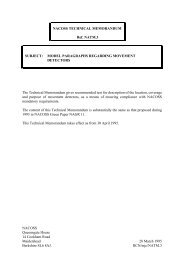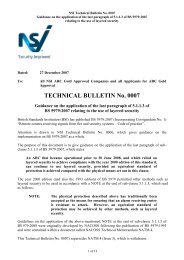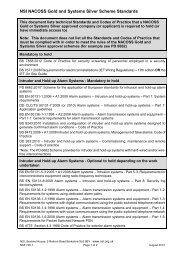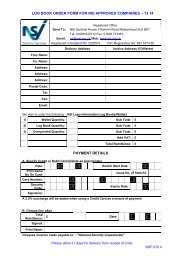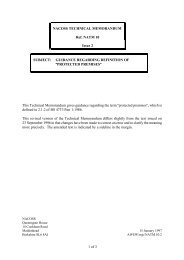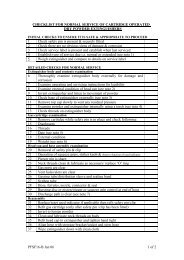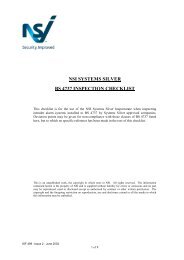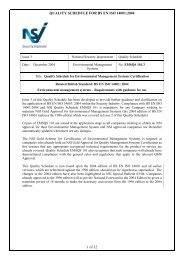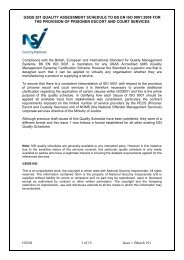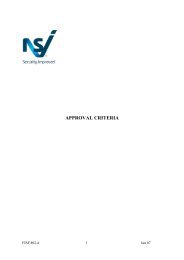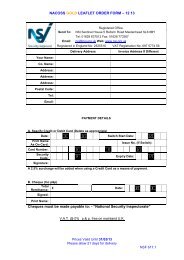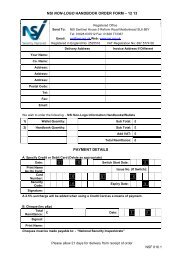NSI Quality Schedule FSQS121 - National Security Inspectorate
NSI Quality Schedule FSQS121 - National Security Inspectorate
NSI Quality Schedule FSQS121 - National Security Inspectorate
Create successful ePaper yourself
Turn your PDF publications into a flip-book with our unique Google optimized e-Paper software.
<strong>FSQS121</strong> – THE <strong>NSI</strong> QUALITY SCHEDULE FOR THE APPLICATION OF BS EN<br />
ISO 9001:2008 TO THE <strong>NSI</strong> FIRE GOLD CERTIFICATION SCHEME<br />
Compliance with the British, European and International Standard for <strong>Quality</strong><br />
Management Systems, BS EN ISO 9001 is mandatory for any UKAS Accredited<br />
QMS (<strong>Quality</strong> Management Systems) Certification Scheme. However the Standard is<br />
a generic one that is designed such that it can be applied to virtually any organization<br />
whether they are manufacturing a product or supplying a service.<br />
The <strong>NSI</strong> Fire Gold Scheme is not only a UKAS Accredited QMS scheme but it is also<br />
a UKAS Accredited PC (Product Certification) scheme. Consequently organizations<br />
approved under the scheme not only have to demonstrate that they operate an<br />
effective quality management system, but also that the product supplied is compliant<br />
with the technical or product standards demanded by the end users and other<br />
relevant stakeholders.<br />
The <strong>NSI</strong> Fire Gold Scheme is also Accredited under the BAFE (British Approvals for<br />
Fire Equipment) Fire Protection Industry Scheme SP203 for the design, installation,<br />
commissioning and maintenance of fire detection, alarm and suppression systems.<br />
This and the <strong>NSI</strong> requirements require that systems are designed, installed,<br />
commissioned and handed over by trained and, where required security screened<br />
personnel, to the appropriate product standards such as BS 5839.<br />
Some of the BAFE Scheme Requirements and the relevant technical/product<br />
standards such as BS 5839 directly impact on the intent and application of particular<br />
clauses in BS EN ISO 9001 and it is therefore essential that <strong>NSI</strong> provide further<br />
guidance and clarification on their application. This <strong>Quality</strong> <strong>Schedule</strong> provides such<br />
guidance and clarification on BS EN ISO 9001 and compliance with it is consequently<br />
a condition of any <strong>NSI</strong> Fire Gold Approval.<br />
Issue 5 of this <strong>Quality</strong> <strong>Schedule</strong> was issued to reflect the change of wording in the<br />
2008 edition of BS EN ISO 9001 that was published on the 15 th November 2008 (see<br />
also <strong>NSI</strong> Technical Bulletin 011). The opportunity has also been taken to align the<br />
<strong>Quality</strong> <strong>Schedule</strong> with the format recently issued for other <strong>NSI</strong> <strong>Quality</strong> schedules e.g.<br />
SSQS 101 for the NACOSS Gold Scheme.<br />
Issue 6 of this <strong>Quality</strong> <strong>Schedule</strong> has been issued to ensure Control of Records is<br />
compatible with BAFE scheme documents SP203-1 and SP203-3.<br />
NATIONAL SECURITY INSPECTORATE<br />
FSQS 121 Issue 6 September 2012<br />
Page 1 of 22
<strong>FSQS121</strong> – THE <strong>NSI</strong> QUALITY SCHEDULE FOR THE APPLICATION OF BS EN<br />
ISO 9001:2008 TO THE <strong>NSI</strong> FIRE GOLD CERTIFICATION SCHEME<br />
Sentinel House, 5 Reform Road, Maidenhead, Berkshire, SL6 8BY<br />
Telephone: 01628 637512/0845 006 3003 Fax: 01628 773367<br />
1. INTRODUCTION<br />
1.1 <strong>Quality</strong> <strong>Schedule</strong>s are designed specifically for a particular sector of industry<br />
and are used to amplify the requirements of the <strong>Quality</strong> Management System<br />
Standard and thus provide an agreed basis for audit.<br />
1.2 Use of a <strong>NSI</strong> Fire Gold approved organization for Fire detection and Alarm<br />
Systems provides a high level of assurance that:<br />
(a) The Fire Detection and Alarm System has been designed, installed,<br />
commissioned and handed over by trained and, where required security<br />
screened personnel, to the appropriate product standard (such as BS 5839)<br />
and that contractual agreements are fulfilled.<br />
(b) there is a commitment to customer satisfaction and continual business<br />
improvement derived from the implementation of a <strong>Quality</strong> Management<br />
System specifically designed to meet the needs of the Fire Safety Industry,<br />
such needs having been agreed in consultation with insurers, fire & rescue<br />
services, building control, installers, trade associations and professional<br />
institutions.<br />
1.3 The scope of the approved company is detailed by <strong>NSI</strong> on the Certificate of<br />
Approval and is referenced to this <strong>Quality</strong> <strong>Schedule</strong>.<br />
1.4 The International and UKAS guidance associated with the latest edition of BS<br />
EN ISO 9001:2008 permits a two year transition period for organisations<br />
already approved to the 2000 edition and during this transition period <strong>NSI</strong><br />
approved companies may therefore choose to continue working to BS EN ISO<br />
9001:2000 for a limited time. <strong>NSI</strong> will however, encourage existing approved<br />
companies to upgrade to BS EN ISO 9001:2008, as soon as possible. The<br />
transition period expires on 14 th November 2010 after which BS EN ISO<br />
9001:2000 certification will be invalid.<br />
1.5 The transition period does not apply to new applicants for <strong>NSI</strong> Fire Gold<br />
approval and they shall be audited against BS EN ISO 9001:2008 and this<br />
Issue 5 of the <strong>Quality</strong> <strong>Schedule</strong>.<br />
1.6 <strong>NSI</strong> has already issued Technical Bulletin 0011 explaining the general nature of<br />
the changes to the 2008 edition of BS EN ISO 9001 and this <strong>Quality</strong> <strong>Schedule</strong><br />
takes account of the guidance within the Technical Bulletin. Organisations that<br />
address this <strong>Quality</strong> <strong>Schedule</strong> will therefore also generally satisfy the Technical<br />
Bulletin.<br />
1.7 The previous issue of this quality schedule focussed on the fact that since the<br />
2000 edition of BS EN ISO 9001 was issued there has been less emphasis on<br />
documented procedures and more on defining the processes and controlling<br />
the same. The 2008 edition to the standard makes no significant change to this<br />
and it is still relevant to reference the need for only six mandatory procedures.<br />
However, even if the Standard does not require a documented procedure, it<br />
FSQS 121 Issue 6 September 2012<br />
Page 2 of 22
<strong>FSQS121</strong> – THE <strong>NSI</strong> QUALITY SCHEDULE FOR THE APPLICATION OF BS EN<br />
ISO 9001:2008 TO THE <strong>NSI</strong> FIRE GOLD CERTIFICATION SCHEME<br />
may still be the best way to define the process requirements and ensure they<br />
are understood and consistently applied. Note: A documented procedure may<br />
be a detailed written procedure or a simple process flowchart, depending on the<br />
complexity of the process.<br />
2. SCOPE<br />
2.1 This <strong>Quality</strong> <strong>Schedule</strong> is for use on the <strong>NSI</strong> FIRE Gold Scheme and compliance<br />
with the same is a condition of approval.<br />
2.2 This <strong>Quality</strong> <strong>Schedule</strong> sets out the criteria for auditing the <strong>Quality</strong> Management<br />
Systems of organizations engaged in the design, installation, commissioning,<br />
handover and maintenance of Fire Detection & Alarm Systems and does not in<br />
any way diminish the <strong>NSI</strong> Regulations or the defined Scheme Criteria.<br />
2.3 In common with previous practice, this <strong>Schedule</strong> retains the alignment with the<br />
main clause numbers of the BS EN ISO 9001 Standard. Where special<br />
application of the Standard is considered necessary, this is stated.<br />
2.4 Requirements of this <strong>Quality</strong> <strong>Schedule</strong> that must be satisfied are shown in<br />
normal text and are further emphasised by the use of “shall” or “must”. Where<br />
additional guidance is given it is reproduced in italics and often emphasised by<br />
the use of “may” or “can” within the text.<br />
3. OTHER QUALITY SCHEDULES<br />
SSQS 101 for the NACOSS Gold Scheme for organizations engaged in the<br />
design, planning, installation and maintenance of Electronic <strong>Security</strong> Systems.<br />
SSQS 102 for the <strong>NSI</strong> ARC Gold Scheme.<br />
4. QUALITY SYSTEM REQUIREMENTS<br />
4.1 General<br />
The general requirements for the quality management system set out in clause<br />
4.1 of BS EN ISO 9001: 2008 shall apply.<br />
This includes the requirement to determine the processes needed, their<br />
sequence and interaction, and where applicable how to monitor and measure<br />
them. The 2008 edition now refers to “analysis and improvement” as an actual<br />
process, which supports the view that continual improvement must not just be<br />
as a consequence of actions taken to address non-conformity.<br />
One of the best ways to evidence that all relevant processes have been defined<br />
is to produce an overall flowchart which follows the normal sequence of events.<br />
When determining the processes needed, organizations shall not just address<br />
those carried out in-house but shall clearly define and control those that are<br />
subcontracted or outsourced. It shall also be clear that outsourcing a process<br />
does not absolve the organisation of its responsibility of compliance with all<br />
customer, statutory and regulatory requirements.<br />
FSQS 121 Issue 6 September 2012<br />
Page 3 of 22
<strong>FSQS121</strong> – THE <strong>NSI</strong> QUALITY SCHEDULE FOR THE APPLICATION OF BS EN<br />
ISO 9001:2008 TO THE <strong>NSI</strong> FIRE GOLD CERTIFICATION SCHEME<br />
In principle only the installation module of work can be subcontracted to an<br />
organisation that is in itself not BAFE SP203 Approved for fire detection and<br />
alarm work.<br />
4.2 Documentation requirements<br />
4.2.1 General<br />
No additional requirements apply to this sub-clause of BS EN ISO 9001: 2008<br />
except that the ‘structure’ of the <strong>Quality</strong> Management System shall be clearly<br />
described.<br />
The actual structure of the QMS is left to individual company preference as long<br />
as it can be determined that all clauses of BS EN ISO 9001:2008 and this<br />
<strong>Quality</strong> <strong>Schedule</strong> are clearly addressed. One approach would be to have a slim<br />
line policy manual addressing all clauses that then provides the linkage to the<br />
supporting procedures and process flowcharts which then link to any specific<br />
work instructions and the standard forms to be completed.<br />
The 2008 edition does however include a clarification that a “single document<br />
may address the requirements for one or more procedures and a requirement<br />
for a documented procedure may be covered by more than one document”.<br />
There have been cases in the past where interested parties have taken a view<br />
that for example a separate documented procedure is required for clause 8.3<br />
Control of nonconforming product and clause 8.5.2 Corrective action. The 2008<br />
edition makes it much clearer that this is not the intent and that a combined<br />
procedure is acceptable provided it still effectively addresses both clauses.<br />
4.2.2. <strong>Quality</strong> Manual<br />
The <strong>Quality</strong> Manual shall provide a clear audit trail to supporting<br />
documentation. The justification for any exclusion to the standard shall be<br />
detailed in the <strong>Quality</strong> Manual and although the standard in principle, allows<br />
exclusions to any part of section 7, <strong>NSI</strong> generally find that it is only exclusions<br />
to the Development aspects of clause 7.3 that can be justified (see also section<br />
7.3).<br />
4.2.3 Control of documents<br />
There shall be a documented Procedure for document and data control, which<br />
shall be intended to insure that the latest issues of all relevant documents are<br />
controlled under the <strong>Quality</strong> System.<br />
Within the procedures for document and data control: -<br />
<br />
provision shall be made to list the issue of relevant external documents<br />
including those called up in the <strong>NSI</strong> Regulations and Scheme Criteria,<br />
Fire Service Policies and other applicable Standards, Regulations,<br />
Codes of Practice etc.<br />
FSQS 121 Issue 6 September 2012<br />
Page 4 of 22
<strong>FSQS121</strong> – THE <strong>NSI</strong> QUALITY SCHEDULE FOR THE APPLICATION OF BS EN<br />
ISO 9001:2008 TO THE <strong>NSI</strong> FIRE GOLD CERTIFICATION SCHEME<br />
<br />
<br />
provision shall be made to list the issue status of internal documents<br />
pertinent to the company’s own quality management system, including<br />
procedures and any process flow-charts.<br />
if documents and records are held electronically, the following<br />
safeguards and protocols shall be observed: -<br />
4.2.4 Control of records<br />
a) where a document includes a customer signature, the document<br />
shall be held electronically as a facsimile copy, including a<br />
facsimile copy of the signature.<br />
alternatively, traceability from a customer signature on a hard<br />
copy to an electronically held record will be acceptable. Where<br />
documents held electronically require authorisation (say<br />
customer specification) then issue status must be allocated and<br />
access rights controlled by password entry at appropriate levels<br />
of authorisation.<br />
Where a Firm introduces other arrangements, it shall be required<br />
to demonstrate that the above principles of authorisation and<br />
agreement are upheld.<br />
b) reasonable and secure backup arrangements shall be in place,<br />
and shall be strictly adhered to.<br />
c) backup records shall be securely held (preferably in a fire<br />
resistant container or off-site).<br />
d) there shall be ready access to the information for the purpose of<br />
<strong>NSI</strong> inspection/assessment/surveillance, etc.<br />
Note: It is the responsibility of the Company to determine whether<br />
specific contractual documents are legally required to be<br />
originals.<br />
A documented Procedure shall be established which defines the controls<br />
needed for identification, storage, protection, retrieval, retention time and<br />
disposition of the quality records developed to provide evidence of<br />
conformance and effective operation of the <strong>Quality</strong> Management System.<br />
Records in respect of Contracts (including survey, design, quotations,<br />
installation, commissioning, verification, handover, modification and ‘as fitted<br />
drawings’) shall be maintained and made readily accessible for a minimum of<br />
12 years from the date of handover or until some other organisation, e.g. the<br />
owner of the installation formally takes responsibility for their ongoing storage<br />
and maintenance,<br />
System records for maintenance, disconnection, historical and false alarm<br />
records shall be held for the life of the contract plus a minimum of two (2) years,<br />
except where permitted otherwise in the relevant product standard.<br />
For security screening records see clause 6.2.3<br />
FSQS 121 Issue 6 September 2012<br />
Page 5 of 22
<strong>FSQS121</strong> – THE <strong>NSI</strong> QUALITY SCHEDULE FOR THE APPLICATION OF BS EN<br />
ISO 9001:2008 TO THE <strong>NSI</strong> FIRE GOLD CERTIFICATION SCHEME<br />
5. MANAGEMENT RESPO<strong>NSI</strong>BILITY<br />
5.1 Management commitment<br />
No additional requirements apply to this sub-clause of BS EN ISO 9001: 2008.<br />
5.2 Customer focus<br />
No additional requirements apply to this sub-clause of BS EN ISO 9001: 2008<br />
5.3 <strong>Quality</strong> policy<br />
In addition to the requirements to this sub-clause of BS EN ISO 9001: 2008 the<br />
Policy Statement shall include a commitment to comply with this <strong>Quality</strong><br />
<strong>Schedule</strong>, an intention to meet industry agreed Codes of Practice, any relevant<br />
product standards and applicable legal requirements.<br />
Accredited certification bodies for any management systems certification now<br />
have to comply with a new generation of standards that increasingly take the<br />
view that organisations should not be approved if there are any breaches of<br />
applicable legislation. This is reflected in the introduction to BS EN ISO<br />
9001:2008 where use of the Standard now includes assessment of an<br />
organisations ability to meet statutory requirements applicable to the product<br />
(also expressed as legal requirements).<br />
<strong>NSI</strong>, as a UKAS (United Kingdom Accreditation Service) Accredited<br />
Certification Body shall not recommend approval to BS EN ISO 9001:2008 if<br />
there are known breaches of legal requirements that directly relate to the<br />
product or service provided.<br />
Organisations wishing to obtain or maintain <strong>NSI</strong> Approval under the <strong>NSI</strong> Fire<br />
Gold Scheme shall include a commitment in their Policy Statement that it is<br />
their intent to comply with applicable legal requirements and periodically<br />
evaluate compliance with the same as an input to management review.<br />
Appropriate management shall also demonstrate that they are generally aware<br />
of the prime legislation that impinges on their area of responsibility and<br />
authority.<br />
For example if an operations manager deploying installation engineers had no<br />
understanding that there was any legislation that relates to working at height<br />
and was not aware of his health & safety obligations then it could hardly be<br />
argued that he is competent to perform his duties and it would not only be an<br />
issue in terms of potential legal nonconformity but also in terms of clause 6.2.2<br />
Competence, training and awareness.<br />
For companies who are also incorporating the requirements of the BAFE<br />
Scheme Document SP 203 the Policy Statement must also include a reference<br />
to the modules of work that the quality management system covers.<br />
5.4 Planning<br />
5.4.1 <strong>Quality</strong> objectives<br />
FSQS 121 Issue 6 September 2012<br />
Page 6 of 22
<strong>FSQS121</strong> – THE <strong>NSI</strong> QUALITY SCHEDULE FOR THE APPLICATION OF BS EN<br />
ISO 9001:2008 TO THE <strong>NSI</strong> FIRE GOLD CERTIFICATION SCHEME<br />
No additional requirements apply to this sub-clause of BS EN ISO 9001: 2008.<br />
5.4.2 <strong>Quality</strong> management system planning<br />
As detailed in the standard.<br />
Examples of situations where changes to the quality management system are<br />
to be considered are: -<br />
- Acquisitions and joint ventures<br />
- Introduction of new technologies.<br />
- Organisational restructuring<br />
- The use of sub-contractors<br />
5.5 Responsibility, authority and communication<br />
5.5.1 Responsibility and authority<br />
As detailed within the Standard, responsibilities and authorities shall be defined<br />
and communicated within the organisation.<br />
Key factors in determining how such responsibilities and authorities shall be<br />
defined will be the size and complexity of the organisation.<br />
In a large organisation with all sorts of departmental interfaces then it shall<br />
either be through documented job descriptions, a schedule of key personal<br />
responsibilities in the quality manual and/or inclusion within the documented<br />
procedures. In a very small family run organisation provided management and<br />
staff demonstrate on interview a common understanding of everyone’s prime<br />
responsibilities and authorities, it may not be necessary to have them<br />
documented to the same extent.<br />
The <strong>NSI</strong> Fire Gold Scheme specifically requires that certain responsibilities and<br />
authorities are clearly assigned i.e.<br />
- for the ‘Nominated Designer(s)’ see Clause 7.3 Design<br />
- for any ‘Nominated Design Technician(s)’ see Clause 7.3 Design<br />
- for the Systems Performance Executive(s) – SPE<br />
The Nominated Designer(s) is responsible for authorising all fire system<br />
designs and the SPE is responsible for all aspects of fire system performance<br />
such as the monitoring and analysis of unwanted fire alarms and troublesome<br />
fire systems.<br />
5.5.2 Management representative<br />
As detailed within the Standard, but the 2008 edition now states that the<br />
management representative appointed by top management must be a member<br />
of the organisation’s management.<br />
FSQS 121 Issue 6 September 2012<br />
Page 7 of 22
<strong>FSQS121</strong> – THE <strong>NSI</strong> QUALITY SCHEDULE FOR THE APPLICATION OF BS EN<br />
ISO 9001:2008 TO THE <strong>NSI</strong> FIRE GOLD CERTIFICATION SCHEME<br />
This makes it much clearer that it is not normally acceptable to appoint a<br />
subcontract quality consultant as the management representative unless there<br />
is a clear on-going contract which gives him/her the necessary responsibilities<br />
and authorities required by clause 5.5.2 and for all practical purposes they are<br />
almost regarded as a part-time employee.<br />
5.5.3 Internal Communication<br />
No additional requirements apply to this sub-clause of BS EN ISO 9001:2008.<br />
5.6 Management review<br />
5.6.1 General<br />
The general requirements set out in clause 5.6.1 of BS EN ISO 9001:2008 shall<br />
apply.<br />
<strong>NSI</strong> recognise that there are sometimes different views as to who are the top<br />
management personnel who should carry out the review. Each case has to be<br />
reviewed on its own merit, particularly in large multi-layered PLC’s.<br />
It also may not be practicable or necessary for all Directors to be present at the<br />
management review meetings, if and when interviewed on actual audit, they<br />
can demonstrate awareness of significant issues raised at the meetings.<br />
5.6.2 Review input<br />
The Management Review Agenda shall be determined by top management and<br />
shall include, but not be limited to, the following items as appropriate to the<br />
types of fire detection and alarm systems installed:<br />
<br />
<br />
<br />
<br />
<br />
<br />
<br />
<br />
<br />
<br />
<br />
<br />
follow up actions from previous management reviews<br />
the results from internal and external audits (administrative and<br />
technical)<br />
unwanted fire alarm performance and trends<br />
routine maintenance – monthly performance and trends<br />
response to emergency call out – performance and trends<br />
customer satisfaction (including complaints)<br />
resources<br />
training needs<br />
status of preventative and corrective actions and their effectiveness.<br />
performance of subcontractors (including alarm receiving centres)<br />
planned changes that could effect the quality management system<br />
continual improvement initiatives<br />
FSQS 121 Issue 6 September 2012<br />
Page 8 of 22
<strong>FSQS121</strong> – THE <strong>NSI</strong> QUALITY SCHEDULE FOR THE APPLICATION OF BS EN<br />
ISO 9001:2008 TO THE <strong>NSI</strong> FIRE GOLD CERTIFICATION SCHEME<br />
<br />
<br />
<br />
<br />
<br />
<br />
adequacy of <strong>Quality</strong> Policy<br />
adequacy of <strong>Quality</strong> Objectives<br />
new legislation (when appropriate)<br />
infrastructure (when appropriate)<br />
new technology (when appropriate)<br />
evaluation of legal compliance<br />
5.6.3 Review output<br />
No additional requirements apply to this sub-clause of BS EN ISO 9001:2008.<br />
6. RESOURCE MANAGEMENT<br />
6.1 Provision of resources<br />
No additional requirements apply to this sub-clause of BS EN ISO 9001:2008.<br />
6.2 Human resources<br />
6.2.1 General<br />
The general requirements for human resources set out in clause 6.2.1.of BS EN<br />
ISO 9001:2008 shall apply i.e. that personnel performing conformity to product<br />
requirements shall be competent on the basis of appropriate education,<br />
training, skills and experience.<br />
It is not the intention of <strong>NSI</strong> to be too prescriptive regarding how such<br />
competency should be demonstrated, but this and the following clause suggest<br />
that it is useful in most organisations to develop job descriptions for each<br />
identified role and include in them a so-called person or job specification which<br />
can detail the required level of qualifications, experience, skills, attributes etc<br />
that an ideal incumbent should have. Reviewing candidates against the person<br />
or job specification can then enable an organisation to demonstrate that it does<br />
take care to recruit the right people for each identified role in the organisation.<br />
6.2.2 Competence, awareness and training<br />
It is worth emphasising that organizations “shall determine the necessary<br />
competence for all personnel performing work affecting conformity to product<br />
requirements and where applicable, provide training or take other actions to<br />
achieve the necessary competence.<br />
The quoted clause now makes it much clearer that competency is not simply<br />
achieved just by providing some training. The fact that someone receives<br />
training does not guarantee that they will thereafter demonstrate competency in<br />
carrying out their duties.<br />
Again it is not the intent of <strong>NSI</strong> to be too prescriptive, but it is suggested that<br />
organisations should consider a probationary period for all new employees and<br />
formally review their competency before granting confirmed employment.<br />
FSQS 121 Issue 6 September 2012<br />
Page 9 of 22
<strong>FSQS121</strong> – THE <strong>NSI</strong> QUALITY SCHEDULE FOR THE APPLICATION OF BS EN<br />
ISO 9001:2008 TO THE <strong>NSI</strong> FIRE GOLD CERTIFICATION SCHEME<br />
The objective here is to identify and address any areas where their competency<br />
is not immediately indicated and which could indicate a need for further<br />
training/development. Thereafter, there needs to be a process of verifying ongoing<br />
competency which could include feedback from internal and external<br />
audit, formal staff appraisal/evaluation etc.<br />
Organisations shall clearly define and document their process(es) for<br />
determining both initial and on-going competency and ensure that such<br />
processes are subject to periodic internal audit.<br />
In determining and being able to demonstrate the availability of the necessary<br />
competence within the Company it will still be relevant to establish a training<br />
programme that should be in operation that includes, where relevant: -<br />
<br />
<br />
<br />
<br />
<br />
<br />
<br />
surveying skills<br />
installation skills<br />
inspection and test skills (commissioning and handover)<br />
maintenance and service skills<br />
quality procedures and/or documentation appropriate to the<br />
business processes<br />
company standards for quality and control over requirements<br />
internal auditing skills<br />
Training records shall be available for review and shall demonstrate the<br />
effective operation of the above programme and the signature of the person<br />
who has received the training.<br />
Training records shall include evidence to substantiate that staff have the<br />
technical capability to work upon the equipment or systems used.<br />
Note: - It is not mandatory for personnel to attend external training courses.<br />
However, it is recommended that certain personnel do attend such courses if<br />
the Company, as a whole, does not possess the necessary skills in a given<br />
area.<br />
6.2.3 <strong>Security</strong> Screening (An additional requirement of this <strong>Quality</strong> <strong>Schedule</strong>.)<br />
Companies shall adopt a documented policy statement in relation to the<br />
security screening of personnel who visit customer’s premises for the purpose<br />
of selling, designing, installing, commissioning, handover or monitoring fire<br />
detection and alarm systems or who have access to confidential information<br />
regarding such systems or the premises in which such systems are installed or<br />
are to be installed. The documented policy statement should cover staffpersonnel<br />
and also sub-contract personnel. A copy should be available to<br />
customers and prospective customers on request.<br />
The Fire Scheme is not prescriptive as to the content of the policy statement.<br />
However, it should be clear to a reader of the policy statement whether or not<br />
the Company ensures that all personnel visiting customer’s premises or having<br />
FSQS 121 Issue 6 September 2012<br />
Page 10 of 22
<strong>FSQS121</strong> – THE <strong>NSI</strong> QUALITY SCHEDULE FOR THE APPLICATION OF BS EN<br />
ISO 9001:2008 TO THE <strong>NSI</strong> FIRE GOLD CERTIFICATION SCHEME<br />
access to confidential information are security screened in accordance with BS<br />
7858.<br />
The Company’s internal procedures and practices shall ensure that any<br />
contractual obligations regarding use of security screened personnel are met.<br />
6.3 Infrastructure<br />
No additional requirements apply to this sub-clause of BS EN ISO 9001:2008.<br />
6.4 Work environment<br />
No additional requirements apply to this sub-clause of BS EN ISO 9001:2008,<br />
but is worth emphasising that the term “work environment” now relates to<br />
conditions under which work is performed including physical, environmental and<br />
other factors (such as noise, temperature, humidity, lighting or weather).<br />
In some instances specific aspects of legislation may apply and if there are any<br />
areas of nonconformity with regard to applicable legislation; <strong>NSI</strong> Approval will<br />
not normally be granted.<br />
7. PRODUCT REALISATION<br />
7.1 Planning of product realisation<br />
Processes for the design, installation, commissioning & handover, verification<br />
and maintenance of fire detection and alarm systems shall be developed to<br />
take into account the need to integrate the technical and regulatory requirement<br />
of the fire industry with the requirements of the quality management system.<br />
The extent and form of the documentation required shall take account of the<br />
need to provide evidence:-<br />
<br />
<br />
<br />
<br />
<br />
<br />
<br />
<br />
that contractual obligations are agreed and understood by all parties.<br />
that system design specifications and drawings reflect the level of life<br />
safety and/or building protection required.<br />
of the competency of staff<br />
the components used on installations meet the technical requirements<br />
of the industry.<br />
of in-process, commissioning and handover inspections including<br />
regulatory handover and maintenance documentation.<br />
of adequate planning and monitoring of installation work and<br />
commissioning work including project management techniques where<br />
appropriate.<br />
of adequate administrative and technical support to installation<br />
personnel on site.<br />
of the appropriate level of on-site supervision, particularly on long<br />
running contracts.<br />
FSQS 121 Issue 6 September 2012<br />
Page 11 of 22
<strong>FSQS121</strong> – THE <strong>NSI</strong> QUALITY SCHEDULE FOR THE APPLICATION OF BS EN<br />
ISO 9001:2008 TO THE <strong>NSI</strong> FIRE GOLD CERTIFICATION SCHEME<br />
Companies are reminded that activities for process control must be<br />
consistent with the specified requirements for Fire Detection and Alarm<br />
Systems. Typical documents that can apply for FD&A systems are BS 5839<br />
Parts 1 & 6 (Pt 8 for Voice Alarms), BS 6266, relevant HTM-0503 Technical<br />
Memorandum (e.g. for hospitals and care residences) etc.<br />
The requirements set out in European Standards will apply when called up<br />
by the contract or additionally advised by <strong>NSI</strong>.<br />
7.2 Customer-related processes<br />
The formal contract review process is set out below. Service Providers are<br />
reminded that associated practices in respect of the agreement for the system<br />
design specification are set out in clause 7.3.<br />
For guidance relevant requirements may be found in the British Standards<br />
associated with FD&A systems such as BS 5839 and BS 6266.<br />
(a)<br />
General<br />
The identity of the persons allocated responsibility and authority to carry<br />
out contract reviews shall be clearly defined and communicated within<br />
the Approved Company (sub clause 5.5.1. of BS EN ISO 9001:2008<br />
refers).<br />
(b)<br />
Review<br />
Contract reviews shall be undertaken: -<br />
(i) Before submission of any tender or quotation, to confirm that the<br />
requirements are adequately defined and documented and that the<br />
Company has the capability and resources to meet the<br />
requirements.<br />
(ii) After receipt of the customer’s reply to any tender or quotation, or on<br />
receipt of a purchase order, to ensure that any changes requested<br />
by the customer can be satisfied.<br />
(c)<br />
(d)<br />
There shall be evidence, by means such as stamp or signature, of all<br />
contract reviews.<br />
Organisations shall make clear in appropriate documentation whether or<br />
not they accept verbal confirmation of orders and, if so, policy shall<br />
require the Company to send a written statement to the customer stating<br />
its understanding of the agreement and confirming that this will be taken<br />
as the agreement unless the customer notifies otherwise in writing.<br />
Amendment to contract<br />
Procedures shall require the Organisations, on completion of the<br />
installation (or their module of the work), to ensure that all amendments<br />
are agreed, recorded and authorised and that the requirements of the<br />
contract (including, if appropriate, a remote signalling connection and<br />
notifications to third parties) are completed.<br />
Records<br />
FSQS 121 Issue 6 September 2012<br />
Page 12 of 22
<strong>FSQS121</strong> – THE <strong>NSI</strong> QUALITY SCHEDULE FOR THE APPLICATION OF BS EN<br />
ISO 9001:2008 TO THE <strong>NSI</strong> FIRE GOLD CERTIFICATION SCHEME<br />
Records of contract reviews shall be held for the life of the contract plus<br />
two (2) years. (See also Clause 4.2.4 of BS EN ISO 9001:2008).<br />
Note: Certain contract information may need to be held for longer<br />
periods to satisfy relevant authorities e.g. HM Revenue & Customs.<br />
(e)<br />
Customer liaison<br />
Effective customer liaison shall be continued through the life of the<br />
contract.<br />
The 2008 edition of BS EN ISO 9001 under clause 7.2.1 makes it clear that<br />
statutory and regulatory requirements shall be determined and a new Note in<br />
the Standard references that supplementary services such as recycling or final<br />
disposal are post delivery activities and shall also be considered.<br />
With any Accredited Management System Certification there is increasing<br />
recognition that Certification ought to give a level of assurance that the<br />
approved organisation is aware of relevant legislation and that it is essentially<br />
compliant. The reference to recycling or final disposal is a useful pointer to the<br />
increasing raft of environmental legislation that applies to organizations whether<br />
or not they choose to implement an Environmental Management System. For<br />
example electronic and electrical equipment can no longer be sent to land fill<br />
(the WEEE Regulations apply) and manufacturers of certain types of equipment<br />
are obliged to have or participate in a take back scheme for the old equipment.<br />
It is strongly recommended that organisations should maintain a consolidated<br />
list of the prime legislation that they believe is relevant to their organisation<br />
(see also clause 5.3).<br />
7.3 Design<br />
The detailed selection, placement and configuration of products and the<br />
interconnection to meet the specified requirements for a particular fire detection<br />
and alarm system are considered to be application design rather than<br />
conceptual design (i.e. development design). For this reason the word<br />
‘development’ has been excluded from the sub-headings of this section on<br />
design (and therefore differs in this respect from the corresponding clauses in<br />
BS EN ISO 9001).<br />
7.3.1 Design planning<br />
Note 1: In the case of FD&A systems attention is drawn to British Standard<br />
Code of Practice BS 5839: Part 1: 2002 and in particular to Section<br />
2 Design Considerations. Where other British Standards or Industry<br />
Codes of Practice are to be called up, within the contract, those<br />
relevant design requirements shall be considered.<br />
Note 2: Design Planning arrangements differing from those set out in 7.3.1<br />
below will be considered by <strong>NSI</strong> for any company wishing to adopt<br />
differing arrangements, provided there is evidence that the<br />
arrangements adopted ensure that the provisions of BS EN ISO<br />
9001:2008 and the relevant technical and other standards, Codes of<br />
Practice, regulatory requirements etc., are met. Any Company<br />
wishing to adopt alternative arrangement should write to the <strong>NSI</strong><br />
office giving details.<br />
a) Controls shall be established to ensure that:<br />
FSQS 121 Issue 6 September 2012<br />
Page 13 of 22
<strong>FSQS121</strong> – THE <strong>NSI</strong> QUALITY SCHEDULE FOR THE APPLICATION OF BS EN<br />
ISO 9001:2008 TO THE <strong>NSI</strong> FIRE GOLD CERTIFICATION SCHEME<br />
<br />
<br />
<br />
<br />
<br />
<br />
the appropriate stages of system design specification<br />
development (viz. design planning, design inputs, design<br />
outputs, design review, design verification, design validation,<br />
and control of design changes; see 7.3 of BS EN ISO<br />
9001:2008) are followed.<br />
the customer is made aware of and agrees to any other<br />
limitations (if any) of the demands of the appropriate<br />
technical standard and regulatory requirements of other<br />
interested parties (e.g. local building control authority, fire<br />
brigade officers, insurers).<br />
the customer is made aware of and agrees to any other<br />
limitations of the design (or to the proposed design) in terms<br />
of adequacy of detection/control and warning/signalling<br />
capability.<br />
the requirements of the customer are translated into a<br />
system design specification that is appropriate to the<br />
premises (or site) where the fire detection and alarm system<br />
is to be installed and that lists the equipment and<br />
components to be supplied, detailing their proposed<br />
locations and containing a general indication of their<br />
coverage and purpose.<br />
the system design specification contains within it a Design<br />
Statement, which includes information on any limitations to<br />
the design in terms of adequacy of detection/control and<br />
warning/signalling capability. (Alternatively, the Design<br />
Statement may be a separate document, provided it is<br />
clearly referenced within the system design specification).<br />
there is consideration of any variations and amendments in<br />
the customer requirements as installation proceeds (or<br />
arising from practicalities coming to notice as installation<br />
proceeds) and the recording of such variations or<br />
amendments between customer and the Company, in the<br />
system design specification, or in properly issued<br />
amendments to the system design specification, or in an “as<br />
fitted system record.<br />
Note: The “as fitted” system record shall include an “as<br />
fitted” drawing and, where appropriate, to scale.<br />
Agreed variations (agreed by the customer with the<br />
Company) to the requirements of the relevant<br />
standard (e.g. BS 5839) shall be documented as a<br />
list.<br />
(b) In discharging its responsibility (see 7.3.1 of BS EN ISO 9001:2008) to<br />
define the responsibilities and authorities for design and to manage the<br />
Interfaces between different groups involved in design:<br />
(1) The Company shall designate one or more suitably competent<br />
individual(s) as “Nominated Designer(s)”.<br />
(2) Each individual designated by the Company as a “Nominated<br />
Designer” shall be competent to undertake the tasks that<br />
include: -<br />
FSQS 121 Issue 6 September 2012<br />
Page 14 of 22
<strong>FSQS121</strong> – THE <strong>NSI</strong> QUALITY SCHEDULE FOR THE APPLICATION OF BS EN<br />
ISO 9001:2008 TO THE <strong>NSI</strong> FIRE GOLD CERTIFICATION SCHEME<br />
(i) Acting as the focal point for matters of the design of the fire<br />
system.<br />
(ii) Assessing the fire risk factors (for example relating to<br />
adequacy of detection/control and warning/evacuation and<br />
signalling capability influencing the design).<br />
(iii) Being conversant with the products and systems specified,<br />
and with any significant limitations inherent in such products<br />
and systems.<br />
(iv) Ensuring that the content of quotations and system design<br />
specifications is compatible with the requirements of the<br />
applicable Technical Standards, and <strong>NSI</strong> Gold Codes of<br />
Practice.<br />
(v) “Signing Off” designs on behalf of the Company.<br />
(vi) Being conversant with installation requirements such that<br />
system design specifications are professionally compiled and<br />
finalised in a manner, which gives clear and unambiguous<br />
information to the customer and to the technicians who install<br />
and commission.<br />
Note; There should be evidence that “Nominated Designers” are willing<br />
to seek advice and guidance as required from other companies<br />
(such as equipment manufacturers) and organisations, and to<br />
develop and to keep up to date their skills by such means as<br />
reading fire magazines and journals, attending conferences and<br />
workshops.<br />
(3) The Company may choose to designate one or more suitably<br />
competent individual(s) as “Nominated Design” Technician(s).<br />
(4) In respect to all functions relevant to the design process (but not<br />
necessarily in respect to his/her other functions) each individual<br />
designated as a “Nominated Design Technician” shall be<br />
responsible to and shall work under the authority and<br />
supervision of a “Nominated Designer”.<br />
(5) Each individual designated by the Company as a “Nominated<br />
Design Technician” shall be competent (within the range of<br />
type(s) of work where he/she acts as a “Nominated Design<br />
Technician”) to undertake tasks that include those listed in (ii),<br />
(iii), (iv), (v) and (vi) of 7.3.1. (b)(2) above, except that<br />
competence in respect of (vi) is not necessary where there is<br />
evidence that the effects of new technologies, technical<br />
standards, national implementation of EU Directives, etc.<br />
relevant to the design processes of the Company have been<br />
adequately considered by a “Nominated Designer” and evidence<br />
that the constraints within which the “Nominated Design<br />
Technician” operates are such as to ensure that these matters<br />
are adequately taken into account in the designs prepared<br />
and/or “signed off” by the “Nominated Design Technician”.<br />
(b) In all cases, a site survey (preferably at initial enquiry stage, or at some<br />
other stage, prior to issue of a quotation and system design proposal, but<br />
always at a stage prior to actual commencement of installation) shall be<br />
undertaken by a “Nominated Designer” or by a “Nominated Design<br />
FSQS 121 Issue 6 September 2012<br />
Page 15 of 22
<strong>FSQS121</strong> – THE <strong>NSI</strong> QUALITY SCHEDULE FOR THE APPLICATION OF BS EN<br />
ISO 9001:2008 TO THE <strong>NSI</strong> FIRE GOLD CERTIFICATION SCHEME<br />
Technician”. Final “sign off” on behalf of the Company of a system design<br />
proposal shall not occur until such a site survey has been completed.<br />
Note. This sub paragraph would not apply to new builds on green or brown<br />
field sites. It applies to retrofit to existing buildings.<br />
7.3.2 Design inputs<br />
No additional requirements apply to this sub-clause of BS EN ISO<br />
9001:2008.<br />
7.3.3 Design outputs<br />
No additional requirements apply to this sub clause of BS EN ISO<br />
9001:2008<br />
7.3.4 Design Review<br />
No additional requirements apply to this sub-clause of BS EN ISO<br />
9001:2008<br />
7.3.5 Design verification<br />
Throughout the installation, commissioning and handover process the<br />
original design and any subsequent changes to that original design must be<br />
verified in order that the completed FD&A system is confirmed as fit for<br />
purpose. This must be an ongoing process for systems contracted to one<br />
Company or for systems contracted to more than one Company (i.e. a<br />
modular approach). In the latter scenario the person or organisation<br />
responsible for verification should be identified at the commencement of the<br />
installation work.<br />
7.3.6. Design validation<br />
Commissioning and handover will fulfil this requirement.<br />
7.3.7. Control of design changes<br />
No additional requirements apply to this sub-clause of BS EN ISO<br />
9001:2008 but control will be closely associated to design verification.<br />
7.4 Purchasing<br />
Activities associated with tasks or services that are subcontracted shall be<br />
consistent with the requirements of <strong>NSI</strong> Gold Code of Practice NACP 3 including<br />
those for security screening (guidelines for security screening are to be found at<br />
6.2.3.)<br />
Component and equipment repairs shall be carried out in accordance with the UK<br />
Regulations covering Electromagnetic Compatibility and then only by the<br />
component manufacturer, by his appointed repair agent, or by a facility that has<br />
been satisfactorily assessed against BS EN ISO 9001 (or an equivalent<br />
specification) by a recognised third party certification body.<br />
7.5 Production and service provision<br />
7.5.1 Control of production and service provision<br />
(a) No additional requirements apply to this sub-clause of BS EN ISO<br />
9001:2008 (but see specific requirements for Service Provision below)<br />
FSQS 121 Issue 6 September 2012<br />
Page 16 of 22
<strong>FSQS121</strong> – THE <strong>NSI</strong> QUALITY SCHEDULE FOR THE APPLICATION OF BS EN<br />
ISO 9001:2008 TO THE <strong>NSI</strong> FIRE GOLD CERTIFICATION SCHEME<br />
Note: Companies are reminded that electrical wiring and installation<br />
must be in accordance with good safety practice and in<br />
compliance with applicable standards and regulations (see the<br />
Scheme Criteria).<br />
(b) Service provision<br />
Companies are reminded that servicing (i.e. maintenance) must be<br />
carried out in accordance with published requirements (e.g. for fire<br />
detection and alarm systems, BS 5839: Part 1: Clause 45)<br />
There shall be provision for adequate administrative and technical<br />
support to service personnel.<br />
For component repairs see 7.4 of this schedule.<br />
The following specific requirements apply to servicing (i.e. maintenance)<br />
of fire detection and alarm systems). The following processes are also<br />
applicable to the Maintenance Module (as understood by the BAFE<br />
SP203 Scheme Document).<br />
(i) Corrective maintenance<br />
For fire detection and alarm systems there shall be a documented<br />
process for false fire alarm management. This process shall identify<br />
provisions for escalating response; the identification and resolution<br />
of troublesome systems; the ongoing performance review by the<br />
Systems Performance Executive; and the following requirements: -<br />
There shall be a record of the date and time of receipt of every<br />
emergency call, together with the date and time of the engineer’s<br />
arrival and the completion of any necessary corrective action. This<br />
information shall be kept (for at least two years) after the event to<br />
which it refers and the customer provided with a copy.<br />
Authorisation from the customer for any temporary disconnection<br />
shall be kept for at least (3) months after reconnection.<br />
There shall be adequate access to spares at all times.<br />
The Company shall audit technician’s holdings of spares to ensure<br />
continued adequate provision (see also 8.2.2. of this <strong>Quality</strong><br />
<strong>Schedule</strong>)<br />
(ii) Preventative maintenance<br />
There shall be a documented process for the planning, scheduling<br />
and implementation of preventative maintenance and also for the<br />
review of preventative maintenance performance.<br />
Attention is drawn to the recommendations contained in <strong>NSI</strong><br />
Technical Memorandum NATM. 7 “Guidelines Concerning Routine<br />
Maintenance Performance of Installers/Maintainers of Intruder<br />
Alarms. This document will be reissued, in due course, to include<br />
Maintainers of Fire Detection and Alarm Systems.<br />
7.5.2 Validation of processes for production and service provision<br />
There shall be a defined process for “in-process inspection” (e.g. during<br />
commissioning) and “final inspection and testing” (e.g. at handover) and<br />
FSQS 121 Issue 6 September 2012<br />
Page 17 of 22
<strong>FSQS121</strong> – THE <strong>NSI</strong> QUALITY SCHEDULE FOR THE APPLICATION OF BS EN<br />
ISO 9001:2008 TO THE <strong>NSI</strong> FIRE GOLD CERTIFICATION SCHEME<br />
shall be consistent with the requirements of the appropriate British<br />
Standard(s) (e.g. BS 5839) and <strong>NSI</strong> Codes of Practice (e.g. NACP 2) and<br />
with specific contract requirements.<br />
The following processes are also applicable to the “commissioning and<br />
handover module”, (as outlined in the BAFE SP203 Scheme Document).<br />
Commissioning engineers are required to have a good working knowledge<br />
of the design of fire detection and alarm systems in order that design<br />
verification can be carried out during the commissioning process.<br />
Particular attention must be given to the issue of the <strong>NSI</strong>/BAFE Certificate<br />
of Compliance, Modular Certificates of Compliance and Modification<br />
Certificates of Compliance. The criteria for issue can be found on the<br />
certificate and the inside cover accompanying the book of blank certificates,<br />
issued to Companies.<br />
Documentation related to the inspection and test status of fire detection and<br />
alarm systems shall include and provide information as follows: -<br />
<br />
<br />
<br />
<br />
<br />
<br />
<br />
<br />
The “as fitted drawings” preferably to scale.<br />
Loop resistance and cable insulation readings<br />
Theoretical standby battery capacity calculations together with the<br />
verified current readings taken at commissioning.<br />
Sounder audibility readings.<br />
Cause and effect verification checks – to include call point/detector<br />
operation, staged evacuation requirements, shutdowns such as<br />
HVAC, gas, plant, lifts etc.<br />
Customer log books.<br />
M & E Manuals where appropriate.<br />
A zone diagram located adjacent to the main control unit.<br />
7.5.3 Identification and traceability<br />
A system of uniquely identifying equipment and documentation shall be<br />
maintained to minimise the potential for miss-filing and ensure documentation<br />
in relation to each contract and the QMS can be readily achieved.<br />
Unless special contractual conditions are imposed by customers, processes<br />
shall reflect the extent of traceability of components required for the Company’s<br />
own purposes, such as for reasons of warranty etc.<br />
All staff who regularly come into contact with clients and their representatives<br />
shall carry an identity card or other equivalent means of identification. Such<br />
identity cards shall as a minimum include a current photograph of the individual,<br />
the name of the organization represented and a contact telephone number for<br />
verification purposes.<br />
Dependent upon the client base and the type of sites visited the organization<br />
may also need to consider incorporating additional information on their identity<br />
cards i.e. issue and expiry dates, signature etc and have clearly defined<br />
procedures to recover identity cards from leavers etc.<br />
FSQS 121 Issue 6 September 2012<br />
Page 18 of 22
<strong>FSQS121</strong> – THE <strong>NSI</strong> QUALITY SCHEDULE FOR THE APPLICATION OF BS EN<br />
ISO 9001:2008 TO THE <strong>NSI</strong> FIRE GOLD CERTIFICATION SCHEME<br />
7.5.4 Customer property<br />
Processes for the takeover of installations shall be consistent with the<br />
requirements of <strong>NSI</strong> Directive NAD 3 “Rules relating to the issue of <strong>NSI</strong><br />
certificates of compliance and related matters”.<br />
In addition to this Companies must hold an appropriate “Scope of Approval” (in<br />
respect to the BAFE Scheme) before a <strong>NSI</strong>/BAFE certificate can be issued. The<br />
BAFE Scheme Document should be read to identify the Scheme’s requirements<br />
on this subject.<br />
The 2008 edition now also includes a useful note to remind organizations that<br />
‘customer property can include intellectual and personal data’.<br />
7.5.5 Preservation of product<br />
No additional requirements apply to this sub-clause of BS EN ISO 9001:2008. It<br />
is important, however, that manufacturers’ instructions are followed particularly<br />
in relation to the use of batteries and to the use of electronic components that<br />
are sensitive to electrostatic charge. The “first in, first out” system of stock<br />
control is recommended for batteries etc.<br />
7.6 Control of monitoring and measuring devices<br />
No additional requirements apply to this sub-clause of BS EN ISO 9001:2008<br />
8 MEASUREMENT, ANALYSIS AND IMPROVEMENT<br />
8.1 General<br />
The general requirements set out in Clause 8.1 of BS EN ISO 9001:2008 shall<br />
apply. Other clauses are qualified as follows: -<br />
8.2 Monitoring and measurement<br />
The performance of the quality management system shall be measured through<br />
the monitoring of the following aspects: -<br />
8.2.1 Customer satisfaction<br />
Sources of customer perception could include: -<br />
the outcome of customer satisfaction surveys<br />
the number of sales arising from recommendations<br />
the number of installations taken over by competitors<br />
letters of recommendation received from satisfied customers<br />
contract retention<br />
trends in false alarm performance<br />
other sources as determined by the Company<br />
8.2.2 Internal auditing<br />
<br />
<br />
<br />
the number of installations deemed as troublesome for reasons<br />
attributable to the installing company (including subcontractor<br />
arrangements)<br />
customer complaints<br />
warranty claims<br />
As specified within BS EN ISO 9001:2008, with the clarification that the audit<br />
programme shall include:-<br />
FSQS 121 Issue 6 September 2012<br />
Page 19 of 22
<strong>FSQS121</strong> – THE <strong>NSI</strong> QUALITY SCHEDULE FOR THE APPLICATION OF BS EN<br />
ISO 9001:2008 TO THE <strong>NSI</strong> FIRE GOLD CERTIFICATION SCHEME<br />
<br />
<br />
<br />
<br />
<br />
technical auditing of each installing technician using appropriate<br />
installation checklists encompassing the specific requirements of the<br />
standards and codes of practice for the fire detection and alarm<br />
systems installed. (This also applies for Companies Approved for<br />
just the module of Installation work (as understood in the BAFE<br />
SP203 Scheme Document)).<br />
technical auditing of each commissioning technician (if such<br />
technicians are used solely for commissioning work) using<br />
appropriate commissioning checklists encompassing the specific<br />
requirements of the standards and codes of practice for the fire<br />
detection and alarm systems installed.<br />
technical auditing of the work of each maintenance technician using<br />
appropriate maintenance schedules encompassing the specific<br />
requirements of the standards and codes of practice for the fire<br />
detection and alarm systems maintained and using checklists as<br />
detailed in the two bullet points immediately above this one.<br />
a documented statement (or statements) of the frequency at which<br />
audits shall be undertaken (i.e. a minimum of one per technician<br />
over a twelve (12) month period and the person(s) nominated by the<br />
Company to undertake the audits. The steps to be taken, if the<br />
installations selected fail to meet the specified criteria shall be<br />
defined and shall include a reference to possible training needs and<br />
or an increase in the frequency and number of the audits.<br />
the capabilities of the Company to itself monitor standards of design,<br />
installation, commissioning and maintenance shall be an auditable<br />
element of the <strong>NSI</strong> Fire Gold Product Assurance Scheme and any<br />
approved organisation shall be able to demonstrate that it is<br />
generally capable of identifying for itself all its own nonconformity.<br />
8.2.3 Monitoring and measurement process<br />
No additional requirements apply to this sub-clause of BS EN ISO<br />
9001:2008.<br />
8.2.4 Monitoring and measurement of product<br />
No additional requirements apply to this sub-clause of BS EN ISO<br />
9001:2008. (see also Product Realisation processes, Clause 7.1).<br />
8.3 Control of nonconforming product<br />
It is important to note that under section 3, the terms and definitions in BS EN<br />
ISO 9000:2008 <strong>Quality</strong> Management Systems – Requirements, the term<br />
“product” also includes “service”. Also the term “product” covers hardware,<br />
software, processed material or any combination of these. The expression<br />
“nonconforming product” is therefore not solely applied to defective components.<br />
Documented Procedures for control of nonconforming product shall provide for<br />
identification of: -<br />
<br />
<br />
fire detection and alarm systems giving repeated problems (i.e. troublesome<br />
systems)<br />
inadequate periodic servicing (i.e. preventative maintenance) performance<br />
FSQS 121 Issue 6 September 2012<br />
Page 20 of 22
<strong>FSQS121</strong> – THE <strong>NSI</strong> QUALITY SCHEDULE FOR THE APPLICATION OF BS EN<br />
ISO 9001:2008 TO THE <strong>NSI</strong> FIRE GOLD CERTIFICATION SCHEME<br />
<br />
<br />
<br />
<br />
temporary disconnections<br />
non-conforming fire detection and alarm systems<br />
defective components<br />
any other type of non conforming product as determined by the Company<br />
Note 1: Means for identifying nonconforming product may be found in other<br />
parts of the <strong>Quality</strong> System, for example through technical auditing of<br />
systems and through investigation of customer complaints.<br />
Note 2: Non-conformance may be identified by a modular contractor with work<br />
carried out by an earlier modular contractor. This may arise through the<br />
verification process. The nonconformity should be documented and<br />
resolved through a process of consultation.<br />
Note 3: Corrective action forms under a corrective action procedure may be<br />
used as a means for recording the existence of nonconforming product<br />
and ensuring that corrective action is taken.<br />
8.4 Analysis of data<br />
Analysis of data shall provide information relating to: -<br />
customer satisfaction (see Clause 8.2.1.)<br />
suppliers of products (including services) (see Clause 7.4)<br />
<br />
core business processes<br />
For the installation and maintenance of fire detection and alarm systems the<br />
following shall be relevant: -<br />
8.5 Improvement<br />
- unwanted or false fire alarm statistics reviewed by the Systems<br />
Performance Executive on an ongoing basis. Such statistics and trends<br />
shall also form part of the management review.<br />
- the level of achievement for preventative (i.e. routine) maintenance<br />
performance. The information recorded shall also form part of<br />
Management Review (as well as providing the information necessary to<br />
deliver any corrective actions that may arise).<br />
- the level of achievement in respect to the eight (8) hour response to<br />
requests for corrective (i.e. emergency) maintenance. The information<br />
recorded shall also form part of Management Review (as well as providing<br />
the information necessary to deliver any corrective actions that may<br />
arise).<br />
-<br />
8.5.1 Continual improvement<br />
8.5.2 Corrective action<br />
No additional requirements apply to this sub-clause of BS EN ISO<br />
9001:2008.<br />
There shall be documented Procedures for the development and<br />
implementation of appropriate corrective actions where a nonconformity<br />
FSQS 121 Issue 6 September 2012<br />
Page 21 of 22
<strong>FSQS121</strong> – THE <strong>NSI</strong> QUALITY SCHEDULE FOR THE APPLICATION OF BS EN<br />
ISO 9001:2008 TO THE <strong>NSI</strong> FIRE GOLD CERTIFICATION SCHEME<br />
is identified, including false alarms, substandard installations, poor<br />
service performance and also customer complaints (for which the<br />
requirements of <strong>NSI</strong> Code of Practice, NACP 5, apply, or alternatively<br />
Annex A to BS ISO 10002) to prevent the recurrence of the nonconformity.<br />
8.5.3 Preventative action<br />
There shall be documented Procedure(s) for the review of the audit<br />
results, service reports, unwanted fire alarm statistics, customer<br />
complaints and other relevant data to identify action required to prevent<br />
the recurrence of any perceived problems.<br />
Note:<br />
Such measures identified in 8.5.2 and 8.5.3 immediately above<br />
are not exhaustive. Corrective and preventative actions may<br />
apply to other areas of the <strong>Quality</strong> Management System.<br />
FSQS 121 Issue 6 September 2012<br />
Page 22 of 22



